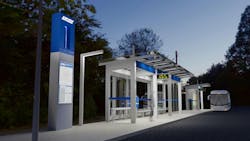City of London, Ontario, receives first shelter for BRT program
The city of London, Ontario, advanced its rapid transit program on April 23, 2024, with the installation of the first rapid transit shelter at the new northbound Ontario Street station at King Street (Western Fair Market).
“This is an exciting milestone towards our vision to have a more connected city,” said London Mayor Josh Morgan. “Having transportation choices means everyone in our community can move through the city safely and efficiently – no matter how you choose to travel.”
The city of London is aiming to install approximately 10 new rapid transit shelters this year, including four stations downtown and sections of the East London Link corridor.
“We are very excited to see this new shelter in place, which will serve as a future stop in Old East Village connecting Londoners to various local destinations. For the project team, this means an opportunity to fine-tune any final details before installing additional shelters in the core,” said City of London Director of Construction and Infrastructure Services Jennie Dann.
The shelter structures will take a couple days to set up, followed by the installation of the electrical, lighting and other amenities during the following weeks.
A large crane will be necessary to complete the installation of the structure, requiring lane restrictions on Ontario Street at King Street until approximately April 26. Sidewalk restrictions and bike lane closures will also be necessary to encourage safety and to complete the installation as efficiently as possible.
Rapid transit shelters highlights
- Rapid transit shelters were designed to provide modularity and a consistent look and feel across the corridors while also accommodating the need for minor customization and value engineering at each location to best fit the shelters within the context of the neighborhood.
- Input received from the community during the environmental assessment helped shape the overall design and amenities while also integrating industry best practices.
- Each rapid transit shelter will feature an obelisk to help identify the location of the rapid transit station and it is intended to be a landmark feature, wayfinding element and branding device.
- Passenger seating area, route information, security cameras, enhanced lighting and tempered glass are a few key features of the new rapid transit shelter.
